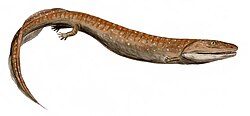| Eoherpeton | |
|---|---|
 | |
| Three-dimensional reconstruction of the skull | |
 | |
| Life restoration | |
| Scientific classification | |
| Domain: | Eukaryota |
| Kingdom: | Animalia |
| Phylum: | Chordata |
| Clade: | Sarcopterygii |
| Clade: | Tetrapodomorpha |
| Order: | † Embolomeri |
| Family: | † Eoherpetontidae Panchen, 1980 |
| Genus: | † Eoherpeton Panchen, 1975 |
| Species | |
E. watsoni(type) | |
Eoherpeton is the only genus of the family Eoherpetontidae in the extinct suborder Embolomeri. It is known from the Visean and Namurian (now Serpukhovian and lower Bashkirian) stages of the Carboniferous of Scotland. [1] [2]





